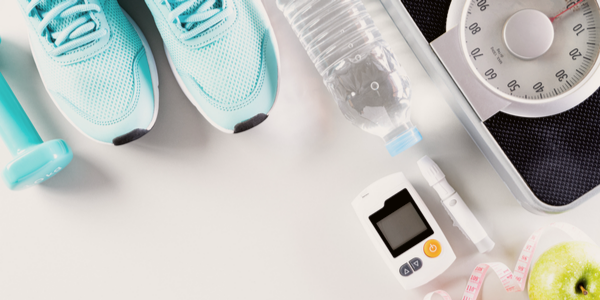
By now most people understand that movement is a necessary part of an overall healthy lifestyle. Consistent exercise improves physical and mental health, reducing the risk of chronic disease and boosting mood among many other potential advantages. Exercise also plays a role in reversing insulin resistance, deeming it especially beneficial for those with diabetes.
Discover how exercise can help control, and even reverse, diabetes in this article!
Review of Diabetes
Recall that there are two main types of diabetes, including types 1 and 2 diabetes.
Type 1 diabetes is an autoimmune condition typically diagnosed early in life. It has strong genetic components and results in zero insulin output from the pancreas. Treatment always involves exogenous insulin and this condition cannot be reversed. Nonetheless, exercise is still important within this population to reduce complications of diabetes.
Type 2 diabetes is a metabolic condition typically diagnosed later in life, though it's becoming more common in children and young adults. Often caused by nutritionally void diets and sedentary lifestyles, type 2 diabetes is characterized by dysfunctional glucose regulation. Over time, the pancreas tires of constantly secreting insulin and cells become insulin resistant. This means blood glucose levels remain high and insulin remains in the blood.
High blood sugar and circulating levels of insulin lead to a slew of other metabolic complications and greatly increases the risk of cardiovascular conditions. Not to mention, insulin resistance makes weight loss nearly impossible. Insulin is an anabolic hormone and as long as it remains within the bloodstream, the body will prioritize storing nutrients as fat while cells remain feeling “starved.” This can cause strong sugar cravings that perpetuate a vicious cycle.
So how can exercise improve and even reverse type 2 diabetes?
Exercise and Type 2 Diabetes
On its own, exercise can lower blood sugar levels and when consistently combined with a nutrient-dense diet and other healthy lifestyle factors, it can help reverse type 2 diabetes! Not just improve, but literally reverse and repair a huge metabolic function.
Exercise achieves this through three main mechanisms:
1. Working muscles prefer to use glucose as fuel. During exercise, muscles will pull glucose from the bloodstream before tapping into their stored glycogen because it’s quick and efficient. This helps lower blood sugar levels.
2. More importantly, the physical act of moving makes cells more sensitive to insulin for hours afterward! This naturally helps regulate blood sugar levels which then creates a cascade of additional beneficial metabolic functions.
3. Beyond the physical effects on blood sugar, regular exercise can lessen feelings of stress and boost mood. Regulating emotional stress can improve diabetes management, as blood sugars tend to rise following stressful moments and situations. High stress may also trigger emotional eating, make it harder to lose weight, and lead to greater weight gain.
(Now you know when someone says exercise is medicine, they aren’t kidding!)
While minimum exercise recommendations are 150 minutes of moderate activity or 75 minutes of vigorous activity per week, diabetics likely do need more than this. These guidelines may suffice for the prevention of diabetes but using exercise as diabetes treatment might look more like 30-45 minutes of moderate activity on 4-5 days per week.
Strength Training and Diabetes
In general, strength training provides the most bang for a buck. Not only does this form of exercise build muscle mass and therefore raise metabolism, but it also sensitizes cells to insulin best.
Strength training doesn’t need to be fancy or require hours in the gym. Some of the most effective strength training programs require 2-4 days of training for 30-45 minutes. They should implement progressive overload and incorporate sufficient rest.
Cardio Exercise and Diabetes
Cardio/aerobic exercise is an effective way to burn calories. When it comes to diabetes, weight loss is often an important piece of the equation. It’s certainly not the whole picture, but research shows that losing certain amounts of body fat can promote favorable metabolic shifts such as improved insulin resistance and hemoglobin A1C (HbA1c) numbers.
While cardio isn’t as effective at reversing insulin resistance, it is a mood-booster that can filter into other areas of life. It’s well known to lower stress, which is an important piece of the puzzle. Stress causes the hormone cortisol to rise and inherently increases blood sugar levels. Therefore, stress management is of vital importance.
Walking, casual bike riding, and dancing are sufficient enough cardio exercises. You don’t need to run three miles every day unless you enjoy doing so. Ultimately, the best exercise routine is one you enjoy, look forward to doing, and can easily maintain in your lifestyle.
Simple physical activities like parking further in lots, taking quick walks around the block after meals, taking stretch breaks, and hosting random kitchen dance parties can all improve insulin sensitivity of cells and overall health.
12 Additional Exercise Tips for Diabetics
1. Start slow and progress over time
2. First focus on strength training and add cardio in for enjoyment
3. Join a gym or group workout classes for extra accountability
4. Hire a personal trainer that can create a tailored program for your unique needs
5. Create SMART goals to stay on track
6. Experiment with different workouts until you find one you thoroughly enjoy
7. Fuel properly before and after exercise for the most health benefit
8. Learn to know when to push and reel it back based on body signals
9. Set out workout gear the day or night beforehand
10. Think of exercise as brushing teeth - necessary for overall health!
11. Check blood sugars, especially if managing type 1 diabetes while exercising
12. Pack glucose tablets or another readily available carb source to prevent and treat hypoglycemia as needed
The Bottom Line
Exercise truly is potent medicine for people with type 2 diabetics. It can be used to prevent or treat type 2 diabetes because of its positive effects on insulin resistance. Exercise not only innately reduces blood sugar levels but also improves cellular sensitivity, which is key in reversing insulin resistance. The mood-boosting effects can’t be downplayed as stress management is vital in reducing diabetic symptoms.
Reap the most benefit by focusing on strength training and adding in bursts of cardio for enjoyment. Remember that progressive overload is the most important aspect of any strength training program but don’t stress about trying to create the perfect routine! Any kind of movement will offer benefits.







